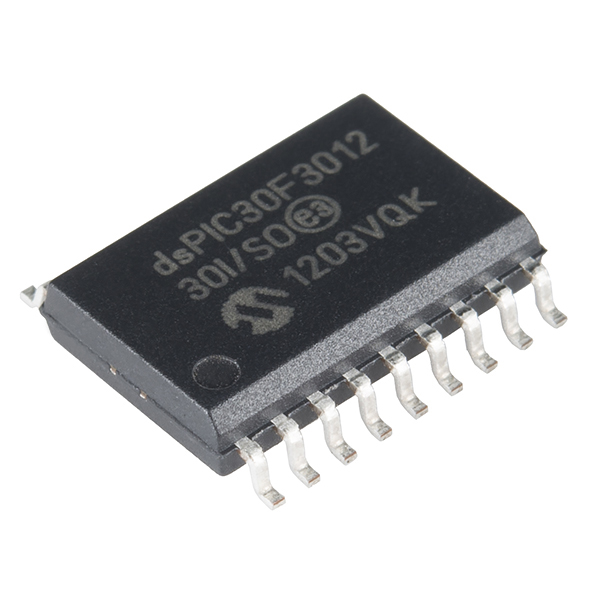Floating Point Co-Processor uM-FPU v3.1 SOIC
The new uM-FPU v3.1 by Micromega has all the proven features of the v3 with some interesting new GPS NMEA string parsing features. The uM-FPU v3.1 chip interfaces to virtually any microcontroller using a SPI, I2C, or serial interface, making it ideal for applications requiring floating point math, including sensor readings, robotic control, GPS, data transformations and other embedded control applications. The uM-FPU v3.1 chip supports 32-bit IEEE 754 compatible floating point and 32-bit integer operations. The uM-FPU v3.1 is RoHS compliant, operates from a 2.7V, 3.3V or 5V supply, and is available in 18-pin DIP, SOIC-18 or QFN-44 packages.
Interface examples are available for BASIC Stamp, Javelin, PICAXE, 16F87x, ARMmite, and ARMexpress controllers.
Long Integer Operations:
- Set, Add, Subtract, Multiply, Divide, Unsigned Divide
- Negate, Abs
- Compare, Unsigned Compare, Status
Conversion Functions:
- Convert 8-bit and 16-bit integers to floating point
- Convert 8-bit and 16-bit integers to long integer
- Convert long integer to floating point
- Convert floating point to long integer
- Convert floating point to ASCII
- Convert floating point to formatted ASCII
- Convert long integer to ASCII
- Convert long integer to formatted ASCII
- Convert ASCII to floating point
- Convert ASCII to long integer
- 18-pin Wide SOIC
- Supports both I2C, SPI, and serial interfaces
- 256 byte instruction buffer
- 128 general purpose 32-bit registers for storing floating point or long integer values
- 8 temporary 32-bit registers to support parentheses in calculations
- 2048 bytes Flash memory for user-defined functions
- 1024 bytes EEPROM for data storage or user-defined functions
- 10 to 20 times faster than uM-FPU V2 for all floating point operations
- Up to 70 times faster for advanced instructions
- Supports 2.7V, 3.3V and 5V supply voltage
- I2C compatible interface up to 400 kHz
- SPI compatible interface up to 15 MHz
- Expanded instruction set, matrix operations, A/D conversion, string handling
- Easy migration from uM-FPU V2
See What's New in V3 for more details on new features
Floating Point Operations:
- Set, Add, Subtract, Multiply, Divide
- Sqrt, Log, Log10, Exp, Exp10, Power, Root
- Sin, Cos, Tan
- Asin, Acos, Atan, Atan2
- Floor, Ceil, Round, Min, Max, Fraction
- Negate, Abs, Inverse
- Convert Radians to Degrees
- Convert Degrees to Radians
- Compare, Status
Floating Point Co-Processor uM-FPU v3.1 SOIC Product Help and Resources
Core Skill: Soldering
This skill defines how difficult the soldering is on a particular product. It might be a couple simple solder joints, or require special reflow tools.
Skill Level: Competent - You will encounter surface mount components and basic SMD soldering techniques are required.
See all skill levels
Core Skill: Programming
If a board needs code or communicates somehow, you're going to need to know how to program or interface with it. The programming skill is all about communication and code.
Skill Level: Competent - The toolchain for programming is a bit more complex and will examples may not be explicitly provided for you. You will be required to have a fundamental knowledge of programming and be required to provide your own code. You may need to modify existing libraries or code to work with your specific hardware. Sensor and hardware interfaces will be SPI or I2C.
See all skill levels
Core Skill: Electrical Prototyping
If it requires power, you need to know how much, what all the pins do, and how to hook it up. You may need to reference datasheets, schematics, and know the ins and outs of electronics.
Skill Level: Competent - You will be required to reference a datasheet or schematic to know how to use a component. Your knowledge of a datasheet will only require basic features like power requirements, pinouts, or communications type. Also, you may need a power supply that?s greater than 12V or more than 1A worth of current.
See all skill levels
Comments
Looking for answers to technical questions?
We welcome your comments and suggestions below. However, if you are looking for solutions to technical questions please see our Technical Assistance page.
Customer Reviews
No reviews yet.



NB - this product comes marked as a Microchip dsPIC (the ones I have here are dsPIC30F3012). This confused the heck out of me, but I guess it turns out these FPUs are implemented in a dsPIC. Crazy!
And therefore way overkill to buy.